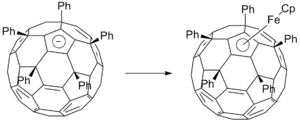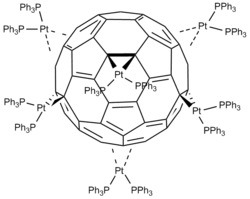Fullerene ligand
A fullerene ligand is a type of ligand encountered in organometallic chemistry with a fullerene coordinated to a metal. Fullerenes are mostly all carbon, spherical molecules, with the most basic being C60. One of the many uses for fullerenes is their ability to be used as ligands in organometallic systems. Fullerenes were first synthesized in 1985 by Harry Kroto, Richard Smalley, et al.[1] The first use of fullerenes as ligands however did not start until 1991, where C60 is used as a ligand on platinum in the system [(Ph3)P]2Pt(η2-C60).[2][3] Since this point, there have been many different systems using fullerenes, involving different transition metals and binding modes. Most of the fullerene ligands are based on C60, though there are systems which use different sized fullerenes, such as C70 as seen with C70Rh(H)(CO)(PPh3)2.[4]
Binding modes
Most commonly fullerene ligands behave similarly to electron-deficient alkenes such as tetracyanoethylene. Thus, they coordinate in a dihapto fashion.[5] This binding occurs on the junction points of two 6-membered rings. Hexahapto and pentahapto bonding is rarely present in these systems. Evidence against this lies in alternating bond lengths of the bonded ring carbons. What instead occurs, is multiple dihapto bonding.[6] This can be observed with the ruthenium complex below:[7]


In this example, each ruthenium is coordinated to a separate pair of carbon centres of a 6-membered ring. This bonding is signified with the prefix a μ3-η2:η2:η2, which indicates that the fullerene bridges three metals, and each metal bonds to one pair of adjacent carbon centres. Higher hapticity is observed complexes of C60Ph5−. In this system, bonding to one of the 5-membered acts like a cyclopentadienyl ligand with multiple substituents.[4]

In this example, the complex has binding very similar to ferrocene, where one the Cp ligands is multiply substituted. Ruthenium can also behave in a very similar manner to the iron and undergo this type of binding. In other cases, a fullerene can bind to multiple metal centres. This is shown with [(Et3P)2Pt]6C60:[8]

With this system, six platinum units are coordinated around the fullerene in an octahedral arrangement. Other types of multiple metal binding can occur as well, some examples of these are seen to the right.

Fullerenes can also be substituents on otherwise conventional ligands as seen with an isoxazoline fullerene chelating to platinum, rhenium, and iridium compounds.[9]

Classification by metal
Platinum, palladium, and least of all, nickel form complexes of the type C60ML2 where L is a monodentate or bidentate phosphorus ligand.[4] They are prepared by displacement of weakly coordinating ligands such as ethylene or acetonitrile:[5] [(Ph3)P]2Pt(C2H4) + C60 → [(Ph3)P]2Pt(η2-C60) + C2H4
Osmium, iridium, and rhodium are used as the metal center as well. With these, the basic formula is C60MLn as well as C70MLn, with n usually equal to 4, but can also be 3. With these metal centers, phosphines are used quite often, as well as hydrogen and carbonyl ligands.[4] The rhodium and iridium anions tend to be slightly unstable if the ligand is triphenylphosphine however, and quickly undergo reduction. If the PPh3 is instead replaced with DIOP (PPh2CH2CHO2)2C(CH3)2), stability is increased. The osmium complexes tend to be more stable than either Rh or Ir. Cobalt and ruthenium anions of these types also have stability issues. Osmium complexes are also able to form multiple Os center complexes such as: Os3(CO)7(PMe3)2(μ3-η2:η2:η2C60). Similarly Ir can form multicentered complexes, with more than one fullerene ligand. In Ir4(CO)3(μ4-CH)(PMe3)2(μ-PMe)2(CNCH2Ph)(μ-η2:η2C60)(μ4-η1:η1:η2:η2C60) there is a four Ir atom center, containing two fullerene ligands with multiple types of mixed binding. Rhodium can also make these types of complexes, where it has been seen up to a cluster of six Rh atoms with two fullerene ligands such as: (C60)Rh6(C60). Ruthenium is able to make five metal complexes and some mixed metal complexes such as: PtRu5C(CO)11(η2-dppe)(μ3-C60).
- 3 Cp*Ru(MeCN)3+ + C60 → {[(Cp*Ru(MeCN)2]3C60}3+ + 3 MeCN
Fullerene complexes of molybdenum(0), tungsten(0), and rhenium with phosphine ligands are well known. A dirhenium complexes is known with the formula Re2(PMe3)4H8(η2:η2C60) where two of the hydrogen act as bridging ligands.[4]
Uses
Although no application has been commercialized, fullerene complexes are of interest as potential catalysts,[10] non-linear optical (NLO) materials,[11] and as supramolecular building blocks.[12]
See also
References
- ↑ Kroto, H.W.; Heath, J.R.; O'Brien, S.C.; Curl, R.F.; Smalley, R.E. (1985). "C60: Buckminsterfullerene". Nature. 318 (6042): 162–163. Bibcode:1985Natur.318..162K. doi:10.1038/318162a0.
- ↑ Fagan, P.J.; Calabrese, J.C.; Malone, B. (1991). "The Chemical Nature of Buckminsterfullerene (C60) and the characterization of a platinum derivative". Science. 252 (5009): 1160–1161. Bibcode:1991Sci...252.1160F. doi:10.1126/science.252.5009.1160. ISSN 0036-8075. JSTOR 2876290.
- ↑ Fagan, P.J.; Calabrese, J.C.; Malone, B. (1991). "A multiply-substituted buckminsterfullerene (C60) with an octahedral array of platinum atoms". Journal of the American Chemical Society. 113 (24): 9408–9409. doi:10.1021/ja00024a079.
- 1 2 3 4 5 Denisovich, L. I.; Peregudova, S. M.; Novikov, Yu. N. (2010). "Electrochemical properties of transition metal complexes with C60 and C70 fullerene ligands (review)". Russian Journal of Electrochemistry. 46 (1): 1–17. doi:10.1134/S1023193510010015.
- 1 2 Spessard, p. 162
- ↑ Spessard, p. 165
- ↑ Hsu, Hsiu-Fu; Shapley, John R. (1996). "Ru3(CO)9(μ3-η2,η2,η2-C60): A Cluster Face-Capping, Arene-Like Complex of C60". J. Am. Chem. Soc. 118 (38): 9192. doi:10.1021/ja962077m.
- ↑ Fagan, Paul J.; Calabrese, Joseph C.; Malone, Brian (1997). "A multiply-substituted buckminsterfullerene (C60) with an octahedral array of platinum atoms". J. Am. Chem. Soc. 113 (24): 9408. doi:10.1021/ja00024a079.
- ↑ RamíRez-Monroy, Armando; Swager, Timothy M. (2011). "Metal Chelates Based on Isoxazoline[60]fullerenes". Organometallics. 30 (9): 2464–2467. doi:10.1021/om200238a.
- ↑ Toganoh, Motoki; Matsuo, Yutaka; Nakamura, Eiichi (2003). "Synthesis and catalytic activity of rhodium diene complexes bearing indenyl-type fullerene η5-ligand". Journal of Organometallic Chemistry. 683 (2): 295–300. doi:10.1016/S0022-328X(03)00465-0.
- ↑ Dragonetti, Claudia; Valore, Adriana; Colombo, Alessia; Righetto, Stefania; Rampinini, Giovanni; Colombo, Francesca; Rocchigiani, Luca; MacChioni, Alceo (2012). "An investigation on the second-order NLO properties of novel cationic cyclometallated Ir(III) complexes of the type [Ir(2-phenylpyridine)2(9-R-4,5-diazafluorene)]+ (R=H, fulleridene) and the related neutral complex with the new 9-fulleriden-4-monoazafluorene ligand". Inorganica Chimica Acta. 382: 72–78. doi:10.1016/j.ica.2011.10.018.
- ↑ Santos, Leandro J.; Carvalhoda-Silva, Dayse; Rebouças, Júlio S.; Alves, Marcos R.A.; Idemori, Ynara M.; Matencio, Tulio; Freitas, Rossimiriam P.; Alves, Rosemeire B. (2011). "Synthesis of new porphyrin/fullerene supramolecular assemblies: A spectroscopic and electrochemical investigation of their coordination equilibrium in solution". Tetrahedron. 67: 228–235. doi:10.1016/j.tet.2010.10.066.
Bibliography
- Spessard, Gary; Miessler, Gary (2010). Organometallic Chemistry ISBN 0195330994